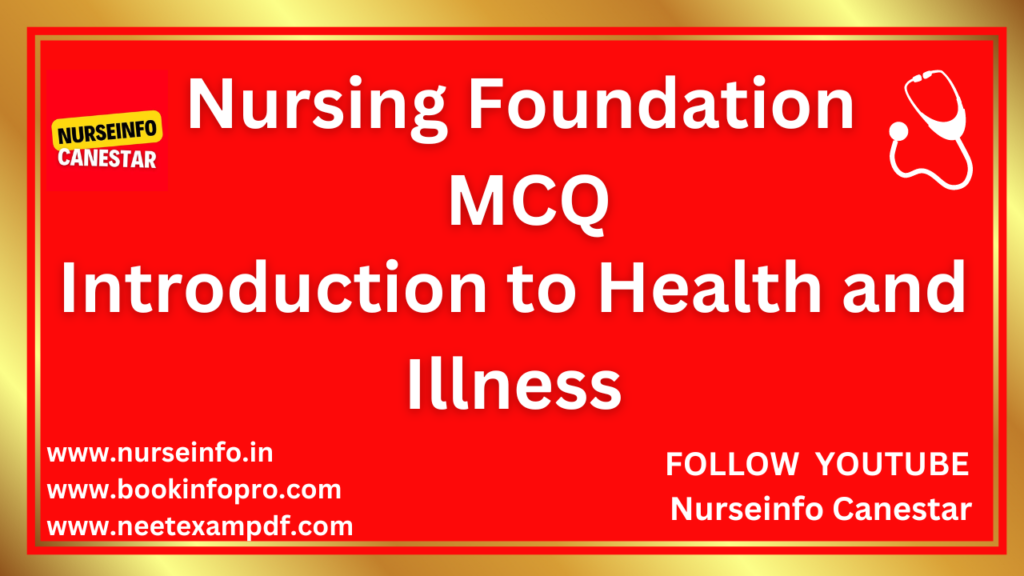MCQ on Nursing Foundation
B.SC NURSING MCQ
FREQUENT ASKED MCQ ON NURSING FOUNDATION – INTRODUCTION TO HEALTH AND ILLNESS
In this page, we have given important nursing foundation mcqs includes health and illness (concept of health, maslow’s hierarchy of needs, health – illness continuum, factors affecting health, causes and risk factors for developing illnesses, types of illness and behavior and impact of illness on patient and family)
Multiple-choice questions (MCQs) are a common type of assessment tool used in educational settings to evaluate a person’s knowledge, understanding, and comprehension of a particular topic.
Which of the following is not a primary goal of nursing care?
A) Health promotion
B) Disease prevention
C) Financial management
D) Health restoration
Answer: C) Financial management
The term “holistic nursing” refers to:
A) Treating only physical symptoms
B) Addressing the mind, body, and spirit in patient care
C) Focusing solely on medical interventions
D) Ignoring psychological aspects of health
Answer: B) Addressing the mind, body, and spirit in patient care
Which of the following is an example of a preventive healthcare measure?
A) Administering antibiotics
B) Providing immunizations
C) Performing surgery
D) Prescribing pain medication
Answer: B) Providing immunizations
What is the primary role of a nurse in health promotion?
A) Administering medication
B) Educating patients about healthy lifestyle choices
C) Diagnosing diseases
D) Conducting surgical procedures
Answer: B) Educating patients about healthy lifestyle choices
Which factor does NOT contribute to socioeconomic health disparities?
A) Access to healthcare services
B) Education level
C) Genetic makeup
D) Income level
Answer: C) Genetic makeup
Which healthcare model emphasizes preventive measures and health education?
A) Biomedical model
B) Health belief model
C) Ecological model
D) Social model
Answer: B) Health belief model
The term “health literacy” refers to:
A) Ability to understand and use health information
B) Physical fitness level
C) Access to healthcare facilities
D) Insurance coverage
Answer: A) Ability to understand and use health information
Which of the following is NOT a social determinant of health?
A) Employment status
B) Gender
C) Genetic predisposition
D) Social support networks
Answer: C) Genetic predisposition
In healthcare, the term “triage” refers to:
A) Sorting patients based on severity of illness or injury
B) Providing emotional support to patients
C) Conducting medical research
D) Administering medications
Answer: A) Sorting patients based on severity of illness or injury
What is the primary purpose of health economics?
A) Maximizing profits for healthcare institutions
B) Analyzing the distribution and consumption of healthcare resources
C) Expanding access to healthcare for all individuals
D) Developing new medical treatments
Answer: B) Analyzing the distribution and consumption of healthcare resources
The health-illness continuum represents:
A) A binary view of health and illness
B) A linear progression from health to illness
C) A dynamic interplay between health and illness states
D) A fixed state of either health or illness
Answer: C) A dynamic interplay between health and illness states
Which concept emphasizes that individuals can move back and forth along the continuum depending on various factors?
A) Health promotion
B) Disease prevention
C) Health belief model
D) Health-illness continuum
Answer: D) Health-illness continuum
Which of the following best describes the relationship between health and illness on the continuum?
A) Health and illness are mutually exclusive states.
B) Health and illness exist independently of each other.
C) Health and illness are interconnected and influenced by multiple factors.
D) Health and illness have no relationship to each other.
Answer: C) Health and illness are interconnected and influenced by multiple factors.

According to the health-illness continuum, a person experiencing minor symptoms such as fatigue or headache would likely be classified as:
A) Completely healthy
B) Mildly ill
C) Moderately ill
D) Severely ill
Answer: B) Mildly ill
Which factor does NOT influence an individual’s position on the health-illness continuum?
A) Socioeconomic status
B) Genetic predisposition
C) Gender
D) Availability of healthcare services
Answer: C) Gender
The health-illness continuum emphasizes the importance of:
A) Treating illness symptoms promptly
B) Preventing all diseases
C) Viewing health and illness as interconnected states
D) Ignoring the social determinants of health
Answer: C) Viewing health and illness as interconnected states
In the context of the health-illness continuum, wellness programs primarily focus on:
A) Treating acute illnesses
B) Preventing chronic diseases
C) Providing palliative care
D) Eliminating all risk factors
Answer: B) Preventing chronic diseases
Which statement best reflects the dynamic nature of the health-illness continuum?
A) Health is a fixed state determined solely by genetics.
B) Illness is always preceded by poor lifestyle choices.
C) Individuals can move between various points on the continuum over time.
D) The continuum is a linear progression from health to illness.
Answer: C) Individuals can move between various points on the continuum over time.
The health-illness continuum acknowledges that:
A) Illness is a result of personal failure.
B) Health is solely determined by biological factors.
C) Optimal health is achievable for everyone.
D) Illness is influenced by multiple factors beyond personal control.
Answer: D) Illness is influenced by multiple factors beyond personal control.
Which healthcare approach recognizes the importance of addressing both physical and mental well-being along the health-illness continuum?
A) Biomedical model
B) Holistic model
C) Curative model
D) Social model
Answer: B) Holistic model
FOLLOW OUR YOUTUBE CHANNEL FOR MORE MCQS – CLICK HERE
